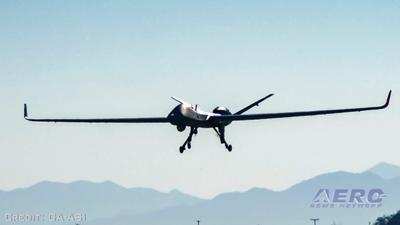Wed, Feb 07, 2024
Lean, Mean Testing Process Assists USAF & GA-ASI on Product Development
General Atomics has capped a series of test flights with the U.S. Air Force Special Operations Command to continue development on its Adaptive Airborne Enterprise concept.

A trio of notable demonstrations proved out a few elements of the project, with the first being a practical application of simultaneous control from a single control station. That test saw one team remotely command a triplet of MQ-9A aircraft from a single government-owned AFSOC RPA Control Suite. The ARCS system is shaping up to be the cornerstone of their MQ-9 test regimen, with an aim to one day use it to control the MQ-9A, the MQ-9B aircraft, and a family of small drones.
The second demo sent an MQ-9A on a firing test using an Altius 600. The 27-lb munition sports a loitering time of more than 4 hours, allowing for a good amount of standoff capability for a passing UAV. The third demo consisted of SATCOM launch & recovery operations, where a trio of MQ-0As were launched from portable control stations before being handed off to a single ARCS unit. Control was then handed off between the ARCS system and the original ground control suite, with the aircraft performing satellite-controlled landings afterwards.
“We have established a great partnership with AFSOC,” said David R. Alexander, president of GA-ASI. “We know our RPA will be a key building block for AFSOC to achieve its Adaptive Airborne Enterprise vision.”
General Atomics has continued to be a common sight around the AFSOC water cooler, thanks to its supportive attitude and convenient product portfolio. The brand has used the MQ-9B to forego some of the typical bureaucracy involved in acquiring developmental aircraft, allowing AFSOC to prototype quicker and more efficiently. That works for both sides, overall - the Air Force gets a leaner, more custom-tailored product and General Atomics gets solid development data as it builds products that warfighters actually want.
“These demonstrations were what we needed to really start to make A2E a reality,” said AFSOC Colonel Trey Olman. “This was the first time we were able to demonstrate control of multiple RPAs from a single workstation, which is important in reducing manpower requirements.”
More News
LinxUs System Adds Capabilities for Data-Driven Operators Textron Aviation announced another option for operators processing their post-flight data, adding interoperability with GE>[...]
Aero Linx: The de Havilland Moth Club Ltd The de Havilland Moth Club evolved from a belief that an association of owners and operators of Moth aeroplanes should be formed to create>[...]
(Pilot) Inadvertently Applied Excessive Braking Action, And The Airplane Nosed Over Analysis: The pilot reported that, while landing at a remote, rough and uneven airstrip in a tai>[...]
“MCADT is committed to rapidly integrating armed first-person view drones into the FMF, enhancing small-unit lethality and providing organic capabilities that warfighters cur>[...]
From 2017 (YouTube Edition): Major Engine Supplier Joins Forces With Small Aircraft Manufacturer… GE recently made an agreement with Venom Aircraft to supply engines for the>[...]
 Citation Operators Get Another Flight Data Connection for QA
Citation Operators Get Another Flight Data Connection for QA ANN's Daily Aero-Linx (06.01.25)
ANN's Daily Aero-Linx (06.01.25) NTSB Final Report: Bellanca 8GCBC
NTSB Final Report: Bellanca 8GCBC Aero-News: Quote of the Day (06.01.25)
Aero-News: Quote of the Day (06.01.25) Classic Aero-TV: High-Speed Match-up - Venom and GE Rebirth A Legend
Classic Aero-TV: High-Speed Match-up - Venom and GE Rebirth A Legend



